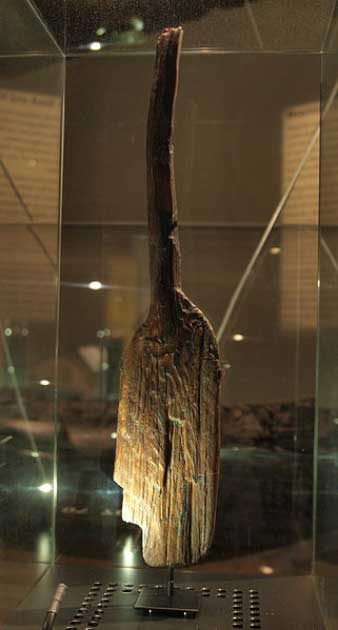Archaeologists digging at a Stone Age campsite in northern Germany have found 10,500-year-old cremated human bones. These Mesolithic era ‘bog bones’ are the oldest human remains found so far in northern Germany.
Not only is this the earliest known human burial in northern Germany, it is also the first time human remains have been found at Duvensee Bog, the site of several campsites from the Mesolithic era or Middle Stone Age (between 15,000 and 5,000 years ago) in the Schleswig-Holstein region, according to Live Science.

The cremated bog bones are about 10,500 years old. They are the first human remains found at any of the Mesolithic sites at the Duvensee bog. (ALSH)
Duvensee Bog is a prehistoric inland lake that has completely silted over in the last 8,000 years and formed a peat bog. The bog’s anaerobic environment naturally preserves organic remains, but there was so little of the burnt bones that it wasn’t until the discovery of a human thigh bone that the archaeologists were able to confirm that they had unearthed a human burial, reports Arkeonews.
The Ancient Duvensee Campsites
The campsite where the bog bones were recovered is only one of at least 20 Mesolithic and Neolithic campsites at Duvensee, and it is located at what was once the western shore of the prehistoric lake. The campsites were used for roasting hazelnuts and spearing fish, both very valuable sources of nutrition for hunter gatherers.

Paddle of Duvensee dating to around 6200 BC. It is one of the world’s oldest surviving wooden paddles. (Archäologisches Museum Hamburg und Stadtmuseum Harburg / CC BY-SA 3.0)
The campsites increased in size over time, possibly indicating a wider spread of hazelnut trees as the climate changed. “In the beginning, we have only small hazelnut roasting hearths, and in the later sites, they become much bigger,” Harald Lubke, an archaeologist at the Center for Baltic and Scandinavian Archaeology, an agency of the Schleswig-Holstein State Museums Foundation, said to Live Science.
The burial campsite was first discovered by archaeologist Klaus Bokelmann and his students in the late 1980s. They discovered worked flint artifacts there not during an archaeological excavation but as a result of a casual challenge issued during a barbecue at a house in a nearby village.
The entire area has yielded flint fragments although flint doesn’t occur naturally there. According to Lubke, this seems to indicate that the hunter gatherers repaired their tools and weapons here when they used the campsites during the annual hazelnut harvest in autumn.
The Cremated Bog Bones
The first sites Bokelmann and his team investigated were on what must have been islands in the ancient lakes. While they found mats made of bark for sitting on the damp soil, pieces of worked flint, and the remains of many Mesolithic fireplaces for roasting hazelnuts, they didn’t find any burials at the island sites. “Maybe they didn’t bury people on the islands but only at the sites on the lake border, which seem to have had a different kind of function,” Lubke told Live Science.
Unlike in the later Mesolithic period, there were no designated burial sites during the early Mesolithic period and the dead seem to have been buried near where they died, according to Lubke. At the Duvensee burial, pieces of the largest bones were left after the cremation, and it’s not clear if they were wrapped in hide or bark before they were buried.

Archaeologists unearth the oldest burial site to date in northern Germany. (Archäologisches Landesamt Schleswig-Holstein)
The find is very significant given that it is extremely rare to find human burials from the early Mesolithic period in Europe. While Late Mesolithic (seventh-sixth millennium BC) graves have been found in northern Germany and southern Scandinavia, the only other early Mesolithic burial found in Europe so far is in Hammelev in southern Denmark, about 120 miles (195 kilometers) to the north of the Duvensee site. Interestingly, that too is a cremation burial, indicating that cremation may have been the preferred funerary practice at the time.
Several sizable bone fragments that were not completely charred were found during the excavation. Lubke hopes that they will be able to recover archaeological DNA from them, Arkeonews reports. The entire grave was raised in a soil block for laboratory study.
A Connection with Mesolithic Sites in Britain
The Duvensee campsites date to around the same time as the Mesolithic site at Star Carr in North Yorkshire and some of the artifacts found there are remarkably similar. At that time and until about 8,000 years ago, Lubke explains that the Schleswig-Holstein region and Britain were connected by a now-submerged region called Doggerland, and Mesolithic groups would have exchanged technologies across the regions.
While archaeologists have been digging at Duvensee Bog since 1923, according to Arkeonews, and have also discovered Stone Age hunter gatherer shelters there, the recent cremation burial find has been very exciting. It has energized them to step up excavations in the region in the hope of discovering what other activities its Mesolithic occupants carried out there. “We’ve only opened a new door here at the moment. But behind it, there are only dark rooms at the moment,” Lubke said.
Top image: 10,500-year-old cremated bog bones were found in northern Germany. Source: ALSH
By Sahir Pandey
Related posts:
Views: 0
 RSS Feed
RSS Feed















 October 23rd, 2022
October 23rd, 2022  Awake Goy
Awake Goy  Posted in
Posted in  Tags:
Tags: 
















